
The Rutaceae is a family, commonly known as the rue or citrus family, of flowering plants, usually placed in the order Sapindales.
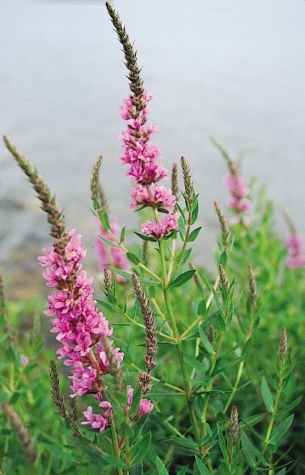
Lythraceae is a family of flowering plants, including 32 genera, with about 620 species of herbs, shrubs, and trees. The larger genera include Cuphea, Lagerstroemia (56), Nesaea (50), Rotala (45), and Lythrum (35). It also includes the members of the former families of the pomegranate and of the water caltrop. Lythraceae has a worldwide distribution, with most species in the tropics, but ranging into temperate climate regions as well.
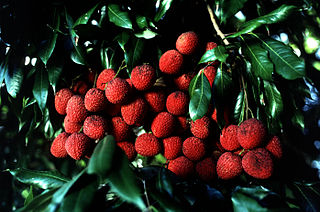
The Sapindaceae are a family of flowering plants in the order Sapindales known as the soapberry family. It contains 138 genera and 1,858 accepted species. Examples include horse chestnut, maples, ackee and lychee.

Koelreuteria paniculata is a species of flowering plant in the family Sapindaceae, native to China. Naturalized in Korea and Japan since at least the 1200s, it was introduced in Europe in 1747, and to America in 1763, and has become a popular landscape tree worldwide. Common names include goldenrain tree, pride of India, China tree, and the varnish tree.
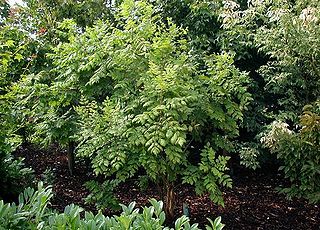
Koelreuteria, also known as chinese lantern tree, is a genus of three species of flowering plants in the family Sapindaceae, native to southern and eastern Asia.

Gentianaceae is a family of flowering plants of 105 genera and about 1600 species.
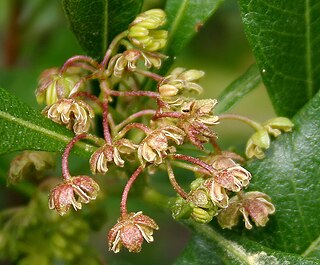
Dodonaea viscosa, also known as the broadleaf hopbush, is a species of flowering plant in the Dodonaea (hopbush) genus that has a cosmopolitan distribution in tropical, subtropical and warm temperate regions of Africa, the Americas, southern Asia and Australasia. Dodonaea is part of Sapindaceae, the soapberry family.

Dodonaea, commonly known as hop-bushes, is a genus of about 70 species of flowering plants in the soapberry family, Sapindaceae. The genus has a cosmopolitan distribution in tropical, subtropical and warm temperate regions of Africa, the Americas, southern Asia and Australasia, but 59 species are endemic to Australia.
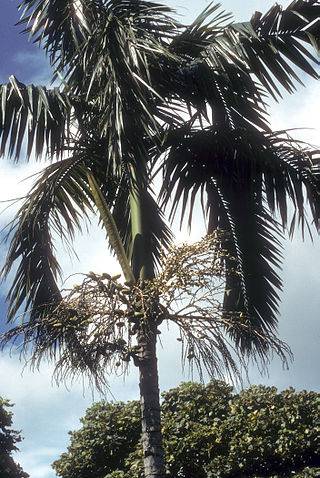
Actinorhytis is a monotypic genus of flowering plant in the palm family found in Oceania and southeast Asia. The lone species, Actinorhytis calapparia is a rain forest inhabitant and has very large fruit. The genus name is from two Greek words meaning 'ray' and 'fold' which describe the endosperm of the seed.

Curculigo capitulata is a stout herb that belongs to the genus Curculigo. It is known by the common names palm grass, whale back, and weevil lily, and by various synonyms, including Molineria capitulata. It ranges from the Himalayas and eastern India through Indochina, southern China, Malesia, and New Guinea to Queensland and the Solomon Islands. The plant has yellow flowers and oblong, papery pleated leaves with very short stems. In China and India, the plant has traditional uses as medicine to treat diseases such as hemorrhoids, asthma, and consumptive cough. In Southeast Asia, the plant is also used as food wrapping and the fibres are used to make fishing nets, ropes and false hair. However, in recent years Molineria capitulata is more often used as ornamental plants in gardens. In recent studies, M. capitulata was also found to have potential in treating several chronic diseases due to its high antifungal, antioxidant, cytotoxic, thrombolytic, anti-inflammatory, and analgesic activities.
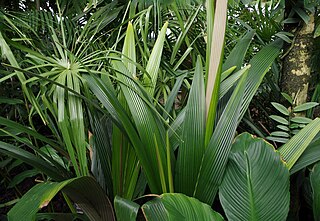
Sommieria is a monotypic genus of flowering plant in the palm family endemic to New Guinea where they grow in rain forest understory. The sole species is Sommieria leucophylla. They resemble the Asterogyne palms but are most closely related to those members of Heterospathe with short stems and sparsely branched inlforescences. The name honors Stephen Sommier, European botanist.
Wimmeria mexicana is a large shrub or small tree, often reaching 8 metres (26 ft) in height, that is common in the Southeastern United States and in regions of Mexico, including the states of Oaxaca, Chihuahua, and central to eastern Sonora. It is commonly called papelío and algodoncillo.
Borthwickia is genus of flowering plants, containing one species, Borthwickia trifoliata from Yunnan, China and Myanmar. The common name in Chinese is 节蒴木. It is a shrub or small tree with evergreen trifoliate leaves, whitish flowers clustered at the tip of the branches, with many stamens, and thin, knobbly, drooping fruits with many small red seeds.
Lepidopetalum is a genus of six species of trees known to science, constituting part of the plant family Sapindaceae.

Solanum virginianum, also called Surattense nightshade, yellow-fruit nightshade, yellow-berried nightshade, Indian nightshade,Thai green eggplant, or Thai striped eggplant, is a medicinal plant used mostly in India. Some parts of the plant, such as the fruit, are poisonous. Solanum surattense Burm. f. and Solanum xanthocarpum Schrad. and Wendl. are synonyms of Solanum virginianum L..
Xerospermum noronhianum is a common Asian tree species described by Carl Ludwig von Blume: it is the type species in the genus and belongs to the Family Sapindaceae. X. noronhianum Blume is the accepted name and there are no subspecies listed in the Catalogue of Life. Morphologically, it is a very variable species, found in many kinds of tropical forests and soils, usually below 300 m altitude and rarely above 1000 m. Its light brown wood is hard and durable, often used in the construction of buildings.

Hypericum foliosum, the shining St John's wort, is a species of flowering plant in the family Hypericaceae. It is a bushy shrub endemic to the Portuguese Azores Islands with golden yellow petals and many stems. The species was described by William Aiton in 1789 and was later placed into section Androsaemum of the genus Hypericum by Norman Robson in 1984. It has a diverse essential oil profile made up mostly of monoterpene hydrocarbons, and significant concentrations of various medicinally useful phenols and carotenoids. Populations of the plant are small in number, but quick to colonize cleared areas like groves, landslide areas, and volcanic ash deposits. It is parasitized by fungus and by moth species, but is not considered endangered by the IUCN. H. foliosum is used in traditional medicine on the Azores for diuretic, hepatoprotective, and antihypertensive purposes. It also has in vitro antibiotic and antioxidizing capabilities.

Harpullia cupanioides is a plant in the Sapindaceae family found in south east Asia: in the Andaman Islands, Assam, Bangladesh, Borneo, Cambodia, Yunnan, Hainan, Jawa, Laos, the Lesser Sunda Islands, Malaysia, Myanmar, New Guinea, Nicobar Islands, the Philippines, the Solomon Islands, Thailand, and Vietnam.

Pometia is a genus of 2 species of rainforest trees, constituting part of the plant family Sapindaceae.
Carpotroche caceresiae is a species of plant in the genus Carpotroche. C. caceresiae has been collected from very wet undisturbed forest on the Caribbean coast of Honduras and Nicaragua, at elevations of up to 600 m (2,000 ft) although it may exist in other areas of Honduras as well as Guatemala.
















